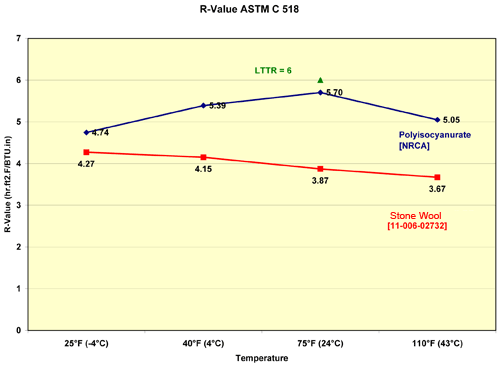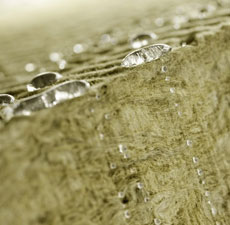Stone Wool Insulation - Improving Building Performance
Thermal Properties
Stone wool has been tested and shown to be an excellent insulator and a vital component of an energy efficient building. Further, its R-value does not change over time because stone wool is not produced with blowing agents, which off-gas and result in lower thermal performance. Not only is the thermal performance of stone wool insulation maintained over its lifetime, but a building's thermal performance can be maintained because of the dimensionally stability of the material. It will not slump in stud spacing causing gaps, will not expand or contract due to temperature variances in a rainscreen or roofing system, all of which contribute to the optimal thermal performance of a building envelope.
In terms of heat transfer as expressed in U or R-value, stone wool insulation performs better than many others, particularly when looked at over time. The Long-Term Thermal Resistance (LTTR) method has generally been followed as the scientific method to describe aged thermal performance of foam insulation products using blowing agents other than air, including polyisocyanurate, polyurethane and extruded polystyrene. This method is based on accelerated aging by conditioning thin slices of foam insulation at a particular temperature for a specified number of days. The method is based on consensus standards in both the United States and Canada and provides a 15-year time-weighted average LTTR value. However, the National Roofing Contractors Association (NRCA) sponsored a ten year study on aged R-values and reported the results at the International Roofing Expo in February 2010. Their data shows that tested R-values for polyisocyanurate insulations over time are actually lower than the R-6 or R-7 per inch as had been commonly believed based on LTTR laboratory testing, and other industry standards including ASTM C 1289. As a result, the NRCA Roofing Manual: Membrane Roof Systems 2011 now recommends that designers use an aged R value for polyisocyanurate insulation of R-5.0 per inch of thickness in locations where heating degree days (HDD) dominate, and R-5.6 in locations where cooling degree days (CDD) dominate.
ASTM C 1289 requires the R-Value to be measured at four temperatures. (See graph) For polyisocyanurate, a peak R-value of 5.7 is obtained at 75°F (24°C) and drops to 4.74 at 25°F (-4°C) and 5.05 at 110°F (43°C). By comparison stone wool tested at these same temperatures indicates that its R-value is remarkably consistent over extended temperature ranges. Stone wool actually increases from the established value of R-3.87 at 75°F (24°C) to R-4.27 at the much colder 25°F (-4°C) while at 110°F (43°C) it decreases only slightly from R-3.87 to R-3.67. Hence, stone wool performs almost the same as polyisocyanurate at lower temperatures and maintains a good R-value as the temperature increases. The stability of stone wool's R-value means that under real life building conditions, it will maintain its thermal performance and yield the intended energy savings in the building. Note that there are many manufacturers of insulation, each making their own claims in their guarantees. In some cases the R-value may not be guaranteed for the period of time assumed by the designer or owner and may only be guaranteed for a very short period of time. Nonetheless, any energy savings calculations or life cycle analysis should take the manufacturers guarantees into consideration since they often reflect the real world experience of the manufacturer.
 |
Third party test results for stone wool insulation compared to polyisocyanurate insulation based on 1" thickness. Data published by the NRCA Image courtesy of Roxul Inc. |
 |
Stone wool insulation repels water Image courtesy of Roxul Inc. |
Water Repellency
Stone wool is a hydrophobic material making it water repellent yet vapor permeable. Water contacting the outer surface will not be absorbed and retained within the insulation, so the R-value is not negatively affected as with other insulation materials such fiberglass. The permeability means that the material is breathable so no double vapor barrier or trapped moisture issues arise. Further, being water-repellent also means that stone wool insulation does not promote rot, corrosion, fungi, mold, or bacterial growth.
An important benefit of stone wool insulation is its “breathability” or ability to allow trapped vapors in a roof or wall assembly to disperse throughout the insulation layer and dry out, effectively maintaining moisture control . The Water Vapor Permeability of stone wool is approximately 30 Perm, as measured in accordance with ASTM E 96-05 'Standard Test Method for Water Vapor Transmission of Materials'. Hence, in roofing applications, water exposure from leaks in a membrane or from condensation within the assembly can be removed by allowing the insulation to vent this moisture. Stone wool will quickly dry out to become fully restored and retain its original characteristics.
When tested in accordance with ASTM C 1511-04 'Standard Test Method for Determining the Water Retention (Repellency) Characteristics of Fibrous Glass Insulation' stone wool demonstrates its superior water management properties. The test procedure consists of fully submerging insulation 127 mm (5") of water for 15 minutes and then measuring the water retained after allowing the product to drain for 60 seconds. The initial water retention of stone wool insulation has been measured at a very low 2.3%. When allowed to dry naturally, the water content drops even lower to below 0.5% within 8 hours of total immersion, over 75% of the initial surface water is dissipated and it returns to complete dryness within a 24 hour period under standard laboratory conditions.









